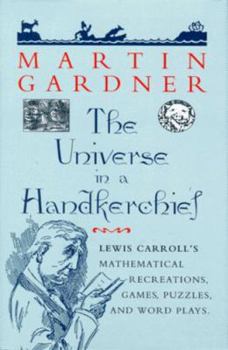The Universe in a Handkerchief: Lewis Carroll's Mathematical Recreations, Games, Puzzles, and Word Plays
Select Format
Select Condition 
Book Overview
This fascinating book takes the reader on a tour of Lewis Carrolls world of mathematical games and word plays. The Universe in a Handkerchief contains scores of Carrolls inventions, illustrating the genius and unique humor that ensured his permanent place in both classic literature and mathematics. "should be received with great enthusiasm by all those who share Gardners fascination with the author of Aliceenjoyable to read and an important addition...
Format:Hardcover
Language:English
ISBN:038794673X
ISBN13:9780387946733
Release Date:October 1998
Publisher:Copernicus Books
Length:158 Pages
Weight:0.90 lbs.
Dimensions:0.6" x 6.4" x 9.6"
Customer Reviews
3 ratings
the editorial review math is exactly correct!
Published by Thriftbooks.com User , 19 years ago
Ok, since there is some confusion on the issue, let me explain how the 2/3 comes about. We are looking for the probability that the second marble is white, given that the first one pulled out of the bag was. First intuitively - if you think about it, if there had been 2 white marbles in the bag to start with you're more likely to have pulled out a white marble on the first draw than you would have if the bag started with one white and one black. That is, knowing that you pulled out a white marble, it's more likely that both marbles were white than it is that there was one of each. Now mathematically - this is called conditional probability. Because of the problem description, before drawing the bag could either contain one of each color or two white marbles, each of these options with probability .5 (50%). If the bag has one of each, your probability of drawing white first is .5, and if it has two whites your probability of drawing white first is 1 (100%). So, the (compound) probability that the bag has one of each *and* you get white first is .5 x .5 = .25 and the probability that the bag has both white and you get white first is .5 x 1 = .5. So, the total probability of getting white first is the sum of the probabilities of these two possible ways of that occuring, .75. Now, the actual probability that was requested was that of there being a white marble in the bag after taking out a white one...that is, what's the probability of the bag having had 2 white marbles if you know it had at least one. This should be the same as the probability of getting two white marbles divided by the probability that the first marble was white. Probability notation for this conditional probability is P(W2|W1) = P(W1 & W2)/P(W2) Which then is .5/.75, which is equal to 2/3 - the number given in the editorial. The result does maybe initially seem to be a strange number, but there is no wiggle room here. It's correct.
Letter to the editorial review
Published by Thriftbooks.com User , 19 years ago
The Editorial has single handedly solved a modern dilemma in the world of Mathematics. I do believe it has been said that it is better to be assumed a fool then to open your mouth and remove all doubt. The final conclusion is that the contradiction leads us to realize a possible incompleteness in the system. Here is how: Solution #1 As the state of the bag, after the operation, is necessarily identical with its state before it, the chance is just what it was, viz. 1/2. Solution #2 Let B and W1 stand for the black or white counter that may be in the bag at the start and W2 for the added white counter. After removing white counter there are three equally likely states: Inside bag------Outside bag W1--------------W2 W2--------------W1 B ---------------W2 In two of these states a white counter remains in the bag, and so the chance of drawing a white counter the second time is 2/3. This contradiction of the first solution might indicate that the system offers an incomplete answer (not that the first answer was wrong).
Essential for Lewis Carroll fans
Published by Thriftbooks.com User , 22 years ago
Lewis Carroll was in "real life" Charles Dodgson, lecturer in mathematics at Oxford University and author of books on geometry and logic. Mathematics intrudes into his children's books, especially Sylvie and Bruno. There is nobody better qualified to explain this side of Lewis Carroll to the non-mathematician than Martin Gardner, author of the Annotated Alice and for many years the compiler of the Mathematical Puzzles column in Scientific American. This book will delight Carroll's many fans and may intrigue many who would not normally be attracted to children's fiction. I also recommend the two books on Lewis Carroll's puzzles by Edward Wakeling; as a professional mathematician, he brings a complementary perspective.





